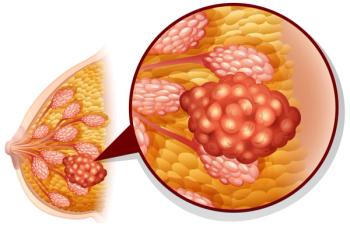
Adagrasib Demonstrates Promising Activity in KRAS G12C+ Advanced NSCLC
Topline findings from the phase 2 KRYSTAL-1 study indicated that adagrasib may hold promise in patients with KRAS G12C–mutant non–small cell lung cancer.
Patients with KRAS G12C–mutant non–small cell lung cancer (NSCLC) appear to achieve clinical benefit after being treated with adagrasib, according to positive topline findings from the phase 2 KRYSTAL-1 trial (NCT03785249).
The analysis, which was conducted in the intent-to-treat arm, showed that a 600 mg twice daily dose of adagrasib resulted in an objective response rate (ORR) of 43% and disease control rate of 80% based on central independent review. The median follow-up for the study was 9 months. Notably, 98.3% of patients were given adagrasib after being treated with chemotherapy or immunotherapy agents.
“The KRAS mutation has historically been challenging to target, leaving patients with limited treatment options,” Charles M. Baum, MD, PhD, president and chief executive officer at Mirati Therapeutics, Inc., said in a press release. “These positive topline data further strengthen our belief in adagrasib as a potentially differentiated therapy for patients with non-small cell lung cancer harboring the KRAS G12C mutation. We look forward to submitting our New Drug Application to the U.S. Food and Drug Administration in the fourth quarter of 2021 and advancing our expanding adagrasib development program, which includes numerous monotherapy and combination studies in KRAS G12C–mutated solid tumors."
The nonrandomized KRYSTAL-1 trial had an estimated enrollment of 565 patients. The primary outcome measure of the study was to characterize the safety of the agent in patients with KRAS G12C–mutant advanced solid tumors, as well as evalute pharmacokinetics and efficacy. The secondary outcome measure included establishing the maximum-tolerated dose and characterizing the safety and tolerability.
To be enrolled on the study, patients were required to have a tumor with a histologically confirmed KRAS G12C mutation. Additionally, unresectable or metastatic disease, being unavailable or unwilling to receive a standard treatment, and adequate organ function were also required.Those who had a history of intestinal lung disease, major gastric surgery, or an inability to swallow oral medications, as well as any other type of active cancer were all exclusion criteria for the study.
Additional findings from the phase 1/1b portion of the KRYSTAL-1 study highlighted an investigator-assessed ORR of 58%, 2 responses of which occurred after being on treatment for 10 months or more. The median follow-up for the analysis was 17.3 months. Additionally, the median treatment duration was 9.5 months and the median duration of response was 12.6 months.
Moreover, 64% of responders were still on treatment and continuing to experience a response. Investigators also reported a median progression-free survival of 8.3 months. The median overall survival was not reached.
In terms of safety, 26% of patients experienced a grade 3/4 treatment-related adverse effect (AE) and 1 patient experienced a grade 5 AE.
Reference
Mirati Therapeutics announces positive phase 2 topline results for investigational adagrasib in patients with KRAS G12C-mutated advanced non-small cell lung cancer. News release. Mirati Therapeutics, Inc. September 20, 2021. Accessed September 20, 2021. https://bit.ly/3zoRpLZ
Newsletter
Stay up to date on recent advances in the multidisciplinary approach to cancer.





















































































